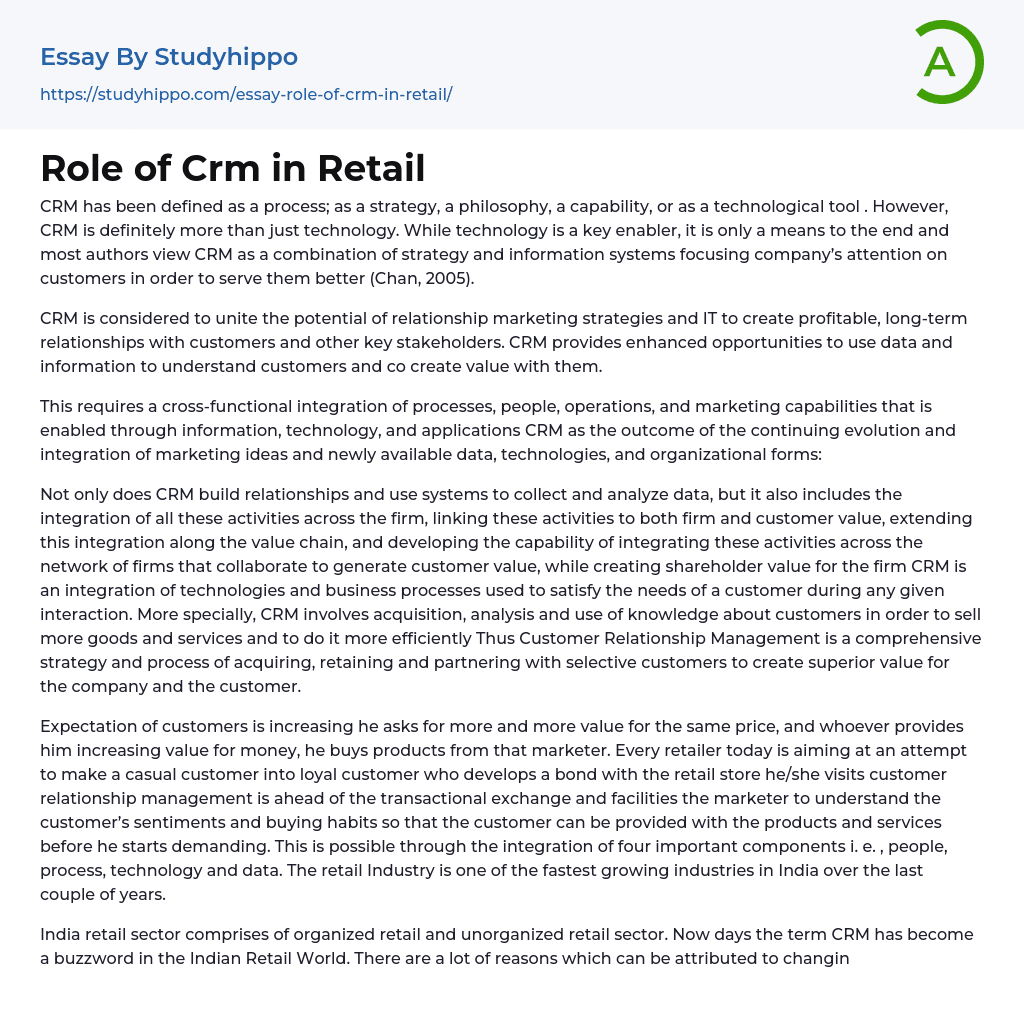CRM has been defined as a process; as a strategy, a philosophy, a capability, or as a technological tool . However, CRM is definitely more than just technology. While technology is a key enabler, it is only a means to the end and most authors view CRM as a combination of strategy and information systems focusing company’s attention on customers in order to serve them better (Chan, 2005).
CRM is considered to unite the potential of relationship marketing strategies and IT to create profitable, long-term relationships with customers and other key stakeholders. CRM provides enhanced opportunities to use data and information to understand customers and co create value with them.
This requires a cross-functional integration of processes, people, operations, and marketing capabilities that is enabled through information, technology, and applications CRM as the outcome of the continuing evolution
...and integration of marketing ideas and newly available data, technologies, and organizational forms:
Not only does CRM build relationships and use systems to collect and analyze data, but it also includes the integration of all these activities across the firm, linking these activities to both firm and customer value, extending this integration along the value chain, and developing the capability of integrating these activities across the network of firms that collaborate to generate customer value, while creating shareholder value for the firm CRM is an integration of technologies and business processes used to satisfy the needs of a customer during any given interaction. More specially, CRM involves acquisition, analysis and use of knowledge about customers in order to sell more goods and services and to do it more efficiently Thus Customer Relationship Management is a comprehensive strategy and process of
acquiring, retaining and partnering with selective customers to create superior value for the company and the customer.
Expectation of customers is increasing he asks for more and more value for the same price, and whoever provides him increasing value for money, he buys products from that marketer. Every retailer today is aiming at an attempt to make a casual customer into loyal customer who develops a bond with the retail store he/she visits customer relationship management is ahead of the transactional exchange and facilities the marketer to understand the customer’s sentiments and buying habits so that the customer can be provided with the products and services before he starts demanding. This is possible through the integration of four important components i. e. , people, process, technology and data. The retail Industry is one of the fastest growing industries in India over the last couple of years.
India retail sector comprises of organized retail and unorganized retail sector. Now days the term CRM has become a buzzword in the Indian Retail World. There are a lot of reasons which can be attributed to changing consumer paradigm and the role played by the organized retailers in making CRM a happening phenomenon. Every retailer in India today is looking at some or the other form of CRM or its prime constituent loyalty based programme. In the retail milieu, where generating and retaining foot falls is the greatest impediment to success, the challenge lies in constantly innovating methods of attracting new customers and keeping their interests alive.
Loyalty programmes as a part of CRM based activity are one of the ways of overcoming this challenge. CRM was invented because customers differ in
their preferences and purchasing habits. If all customers were alike, there would be little need for CRM. Mass marketing and mass communications would work just fine. A customer-centric firm is capable of treating every customer individually and uniquely, depending on the customer's preference. A one-to-one marketing paradigm has emerged that suggests organizations will be more successful if they concentrate on obtaining and maintaining a share of each customer rather than a share of the entire market.
The underlying principle behind relationship marketing is that organizations can enhance customer satisfaction through a relationship and in so doing can enhance their own performance. For such benefits to accrue, relationships must be developed and managed to the customer's satisfaction. In the commercial world the importance of retaining existing customers and expanding business is paramount. Customer retention is an imperative in modern business – a strategy whose objective is to keep a company’s customers and to retain their revenue contribution. Customer retention is the driving force behind Customer Relationship Management (CRM), relationship marketing and loyalty marketing
- Customer essays
- Customer Service essays
- Customer Satisfaction essays
- Target Market essays
- Data Management essays
- Enterprise Resource Planning essays
- Advertising essays
- Audience Theory essays
- Competitor Analysis essays
- Consumer essays
- Marketing Management essays
- Marketing Mix essays
- Marketing Plan essays
- Marketing Research essays
- Marketing Strategy essays
- Point Of Sale essays
- Price essays
- Procurement essays
- Product essays
- Product Differentiation essays
- Promotion essays
- Promotion And Marketing Communications essays
- Retailing essays
- Trademark essays
- Anheuser-busch essays
- Brands essays
- Detergent essays
- Product Placement essays
- Research Design essays
- New Product Development essays
- Advertisement essays
- Brand essays
- Sales Promotion essays
- Advertising campaign essays
- Consumer behaviour essays
- Offer And Acceptance essays
- Wal-Mart essays
- Discover essays
- John Locke essays
- 9/11 essays
- A Good Teacher essays
- A Healthy Diet essays
- A Modest Proposal essays
- A&P essays
- Academic Achievement essays
- Achievement essays
- Achieving goals essays
- Admission essays
- Advantages And Disadvantages Of Internet essays
- Alcoholic drinks essays




